Wine bottle
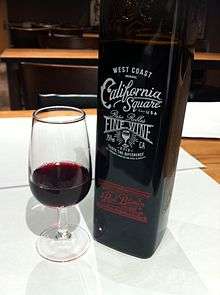
A wine bottle is a bottle used for holding wine, generally made of glass. Some wines are fermented in the bottle, others are bottled only after fermentation.
Recently, the bottle has become a standard unit of volume to describe sales in the wine industry, measuring 750 millilitres (26.40 imp fl oz; 25.36 US fl oz). However, bottles are produced in a variety of volumes and shapes.
Wine bottles are traditionally sealed with cork, but screw-top caps are becoming popular, and there are several other methods used to seal a bottle.[1][2][3]
Sizes
Many traditional wine bottle sizes are named for Biblical kings and historical figures. The chart below[4] lists the sizes of various wine bottles in multiples relating to a standard bottle of wine, which is 0.75 litres (0.20 US gal; 0.16 imp gal) (five 150 mL servings). The "wineglassful"—an official unit of the apothecaries' system of weights—is much smaller at 2.5 imp fl oz (71 ml).
Most champagne houses are unable to carry out secondary fermentation in bottles larger than a magnum due to the difficulty in riddling large, heavy bottles. After the secondary fermentation completes, the champagne must be transferred from the magnums into larger bottles, which results in a loss of pressure. Some believe this re-bottling exposes the champagne to greater oxidation and therefore results in an inferior product compared to champagne which remains in the bottle in which it was fermented.[5]
| Volume (litres) | Ratio | Name | Notes | Champagne | Bordeaux | Burgundy |
|---|---|---|---|---|---|---|
| 0.1875 | 0.25 | Piccolo | "Small" in Italian. Also known as a quarter bottle, pony, snipe or split. | Yes | ||
| 0.2 | 0.2667 | Quarter | Used for Champagne | Yes[6] | ||
| 0.25 | 0.33 | Chopine | Traditional French unit of volume | Yes | ||
| 0.375 | 0.5 | Demi | "Half" in French. Also known as a half bottle. | Yes "Half"[6] | Yes | Yes |
| 0.378 | 0.505 | Tenth | One tenth of a US gallon* | |||
| 0.5 | 0.67 | Jennie | Also known as a 50 cl bottle. Used for Tokaj, Sauternes, Jerez, as well as several other types of sweet wines, also common for cheaper wines in Switzerland. | Yes "Demie" or "Pinte"[6] | ||
| 0.620 | 0.83 | Clavelin | Primarily used for vin jaune. | |||
| 0.750 | 1 | Standard | Yes[6] | Yes | Yes | |
| 0.757 | 1.01 | Fifth | One-fifth of a US gallon* | |||
| 1.0 | 1.33 | Litre | Popular size for Austrian wines. | |||
| 1.5 | 2 | Magnum | Yes[6] | Yes | Yes | |
| 2.25 | 3 | Marie Jeanne | Also known as a Tregnum or Tappit Hen in the port wine trade. | Yes | ||
| 3.0 | 4 | Jeroboam (a.k.a. Double Magnum) | Biblical, First king of Northern Kingdom. "Jeroboam" has different meanings (that is, indicates different sizes) for different regions in France.[7] | Yes[6] | Yes | Yes |
| 4.5 | 6 | Yes | ||||
| 4.5 | 6 | Rehoboam | Biblical, First king of separate Judea | Yes[6] | Yes | |
| 5.0 | 6.67 | McKenzie | Uncommon, primarily found in France | Yes | ||
| 6.0 | 8 | Imperial | Yes | |||
| 6.0 | 8 | Methuselah | Biblical, Oldest Man | Yes[6] | Yes | |
| 9.0 | 12 | Salmanazar | Biblical, Assyrian King | Yes[6] | Yes | Yes |
| 12.0 | 16 | Balthazar or Belshazzar [8] | One of three Wise Men (according to legend) to present gifts at Jesus' nativity; Belshazzar can also denote the co-regent of Babylon during the madness of Nebuchadnezzar, for whom the next-larger bottle size is named. | Yes[6] | Yes | Yes |
| 15.0 | 20 | Nebuchadnezzar[9] | Biblical, King of Babylon | Yes[6] | Yes | Yes |
| 18.0 | 24 | Melchior | One of three Wise Men (according to legend) to present gifts at Jesus' nativity | Yes | Yes | Yes |
| 18.0 | 24 | Solomon | Biblical, King of Israel, Son of David | Yes[6] | ||
| 26.25 | 35 | Sovereign | Reportedly created by Taittinger in 1988 for the launch of the then world's largest cruise liner Sovereign of the Seas[10] | Yes[6] | ||
| 27.0 | 36 | Primat or Goliath | Biblical, stoned by David | Yes[6] | Yes | |
| 30.0 | 40 | Melchizedek or Midas | Biblical, King of Salem | Yes[6] |
* For many years, the US standard (non-metric) wine and liquor bottle was the "fifth", meaning one-fifth of a US gallon, or 25.6 US fluid ounces (757 ml; 26.6 imp fl oz). Some beverages also came in tenth-gallon, half-gallon and one-gallon sizes. In 1979, the US adopted the metric system for wine bottles, with the basic bottle becoming 750 ml, as in Europe.
Shapes
Wine producers in Portugal, Italy, Spain, France and Germany follow the tradition of their local areas in choosing the shape of bottle most appropriate for their wine.
- Port, sherry, and Bordeaux varieties: straight-sided and high-shouldered with a pronounced punt. Port and sherry bottles may have a bulbous neck to collect any residue.
- Burgundies and Rhône varieties: tall bottles with sloping shoulders and a smaller punt.
- Schlegel variety, predominantly used in German wine growing regions: similar to Burgundy bottles, but more slender and elongated.
- Rhine (also known as hock or hoch), Mosel, and Alsace varieties: narrow and tall with little or no punt.
- Champagne and other sparkling wines: thick-walled and wide with a pronounced punt and sloping shoulders.
- German wines from Franconia: the Bocksbeutel bottle.
- The Chianti and some other Italian wines: the fiasco, a round-bottomed flask encased in a straw basket. This is more often used for everyday table wines; many of the higher-grade Chianti producers have switched to Bordeaux-type bottles.
Many North and South American, South African, and Australasian wine producers select the bottle shape with which they wish to associate their wines. For instance, a producer who believes his wine is similar to Burgundy may choose to bottle his wine in Burgundy-style bottles.
Other producers (both in and out of Europe) have chosen idiosyncratic bottle styles for marketing purposes. Pere-Anselme markets its Châteauneuf-du-Pape in bottles that appear half-melted. The Moselland company of Germany has a riesling with a bottle in the shape of a house cat.
The home wine maker may use any bottle, as the shape of the bottle does not affect the taste of the finished product. The sole exception is in producing sparkling wine, where thicker-walled bottles should be used to handle the excess pressure.
Most wine bottles standards have a bore (inner neck) diameter of 18.5 at the mouth of the bottle and increase to 21 mm before expanding into the full bottle.
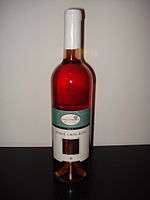 A basic 750 ml bottle in the Bordeaux style of Pinot noir–rosé wine
A basic 750 ml bottle in the Bordeaux style of Pinot noir–rosé wine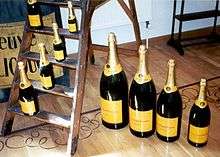 Side-by-side comparison of various sizes of champagne bottles (left to right), on the ladder: magnum, full, half, and quarter; on the floor: Balthazar, Salmanazar, Methuselah, and Jeroboam.
Side-by-side comparison of various sizes of champagne bottles (left to right), on the ladder: magnum, full, half, and quarter; on the floor: Balthazar, Salmanazar, Methuselah, and Jeroboam.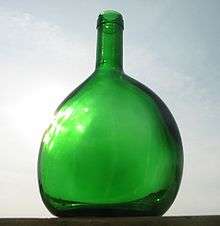 Bocksbeutel shaped wine bottle
Bocksbeutel shaped wine bottle Burgundy bottles
Burgundy bottles_Burgundy_Bottle_.jpg) Comparison of Standard and McKenzie Bordeaux bottles
Comparison of Standard and McKenzie Bordeaux bottles Rioja bottle with gold wire netting
Rioja bottle with gold wire netting
Colors
The traditional colors used for wine bottles are:
- Bordeaux: dark green for reds, light green for dry whites, colorless for sweet whites.
- Burgundy and the Rhone: dark green.
- Mosel and Alsace: dark to medium green, although some producers have traditionally used amber.
- Rhine: amber, although some producers have traditionally used green.
- Champagne: Usually dark to medium green. Rosé champagnes are usually a colorless or green.
Clear colorless bottles have recently become popular with white wine producers in many countries, including Greece, Canada and New Zealand. Dark-colored bottles are most commonly used for red wines, but many white wines also still come in dark green bottles. The main reason for using colored or tinted glass is that natural sunlight can break down desirable antioxidants such as vitamin c and tannins in a wine over time, which affects storability and can cause a wine to prematurely oxidise. Dark glass can prevent oxidation and increase storage life. It is therefore mostly ready-to-drink white wines with a short anticipated storage lifespan which are bottled in clear colorless bottles.
Foils and netting
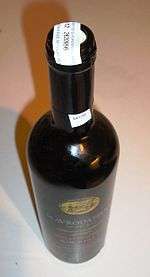
Commercial corked wine bottles typically have a protective sleeve called a foil (commonly referred to as a "capsule") covering the top of the bottle, the purpose of which is to protect the cork from being gnawed away by rodents or infested with the cork weevil and to serve as collar to catch small drips when pouring. The foil also serves as a decorative element of the bottle's label. Foils were historically made of lead; however, because of research showing that trace amounts of toxic lead could remain on the lip of the bottle and mix with the poured wine,[11] lead foil bottleneck wrapping was slowly phased out, and by the 1990s,[12] most foils were made of tin, heat-shrink plastic (polyethylene or PVC), or aluminium or polylaminate aluminium. Sealing wax is sometimes used, or the foil can be omitted entirely.[13] In the US, the FDA officially banned lead foils on domestic and imported wine bottles as of 1996.[14]
Some bottles of wine have a paper strip beneath the foil, as a seal of authenticity, which must be broken before the bottle can be uncorked.
Bottles of high-end Rioja wine may have a covering of gold wire netting, Spaniard Camilo Hurtado de Amézaga, Marqués de Riscal founded a winery in Rioja, in 1858, naming it after his own noble title, which had been created in 1708 by Philip V. He produced award-winning wines which became the preferred wines of King Alfonso XII. Camilo Hurtado de Amézaga invented a wire netting that covered his bottle, thereby preventing counterfeiters from substituting the wine, since it was impossible to remove the netting without breaking it. Modern day bottles of Rioja carry a much finer wire netting as a decoration.[15]
Punts

A punt, also known as a kick-up, refers to the dimple at the bottom of a wine bottle. There is no consensus explanation for its purpose. The more commonly cited explanations include:[1]
- It is a historical remnant from the era when wine bottles were free blown using a blowpipe and pontil. This technique leaves a punt mark on the base of the bottle; by indenting the point where the pontil is attached, this scar would not scratch the table or make the bottle unstable.
- It had the function of making the bottle less likely to topple over—a bottle designed with a flat bottom only needs a small imperfection to make it unstable—the dimple historically allowed for a larger margin of error.
- It consolidates sediment deposits in a thick ring at the bottom of the bottle, preventing much/most of it from being poured into the glass; this may be more historical than a functional attribute, since most modern wines contain little or no sediment.[16]
- It increases the strength of the bottle, allowing it to hold the high pressure of sparkling wine/champagne.
- It provides a grip for riddling a bottle of sparkling wine manually in the traditional champagne production process.
- It consumes some volume of the bottle, allowing the bottle to appear larger for the same amount of wine, which may impress the purchaser.[17]
- Taverns had a steel pin set vertically in the bar. The empty bottle would be thrust bottom-end down onto this pin, puncturing a hole in the top of the punt, guaranteeing the bottle could not be refilled [folklore].
- It prevents the bottle from resonating as easily, decreasing the likelihood of shattering during transportation.
- It allows bottles to be more easily stacked end to end.[17]
- Bottles could be stacked in cargo holds on ships without rolling around and breaking.
- It makes the bottle easier to clean prior to filling with wine. When a stream of water is injected into the bottle and impacts the punt, it is distributed throughout the bottom of the bottle and removes residues.
Environmental impact
Glass retains its color on recycling, and the United Kingdom has a large surplus of green glass because it imports a large quantity of wine but produces very little. 1.4 million tons are sent to landfill annually.[18]
Glass is a relatively heavy packing material and wine bottles use quite thick glass, so the tare weight of a full wine bottle is a relatively high proportion of its gross weight. The average weight of an empty 750 ml wine bottle is 500 g (and can range from 300 to 900 g), which makes the glass 40% of the total weight of the full bottle.[19] This has led to suggestions that wine should be exported in bulk from producer regions and bottled close to the market. This would reduce the cost of transportation and its carbon footprint, and provide a local market for recycled green glass.[20][21] Less radically, box wine is sold in large-size light cardboard and foil containers, though its use has been restricted to cheaper products in the past and as such retains a stigma. Following declining sales of wine boxes in the UK, in 2009 the Office for National Statistics removed them from its Consumer Price Index measure of inflation.[22] Some wine producers are exploring more alternative packagings such as plastic bottles and tetra packs.[23]
See also
- Beer bottle
- Glass bottle
- Kenelm Digby, considered the father of the modern wine bottle
- Tunc
References
- 1 2 Johnson, Hugh (2004). The Story of Wine. Sterling Publishing. ISBN 1-84000-972-1.
- ↑ Jackson, Ron (1997). Conserve Water, Drink Wine: Recollections of a Vinous Voyage of Discovery. Haworth Press. ISBN 1-56022-864-4.
- ↑ MacNeil, Karen (2001). The Wine Bible. Workman. ISBN 1-56305-434-5.
- ↑ "Wine 101: Wine Bottle Sizes and Designations". Retrieved 26 November 2014.
- ↑ "Champagne Bottle Sizes". Retrieved 11 April 2014.
- 1 2 3 4 5 6 7 8 9 10 11 12 13 14 15 "Different bottle styles". The Comité Champagne. Comité Interprofessionnel du vin de Champagne. Retrieved 23 December 2014.
- ↑ "Jeroboam Wine Facts". Retrieved 26 December 2008.
- ↑ "Balthazar, n.". Oxford English Dictionary.
Forms: Also Balthasar, Belshazzar.
- ↑ Manser, Martin H.; Pickering, David H., eds. (2003). The Facts On File dictionary of classical and biblical allusions. New York, NY: Checkmark Books. p. 257. ISBN 9780816048687.
- ↑ "Champagne bottle sizes". BigbBottles.co.uk. Retrieved 23 December 2014.
- ↑ Fisher, Lawrence M. (2 August 1991). "Lead Levels in Many Wines Exceed U.S. Standards for Water". The New York Times. Retrieved 2 January 2010.
- ↑ "CFR - Code of Federal Regulations Title 21". FDA U.S. Food and Drug Administration. Retrieved 27 June 2015.
- ↑ "30 Second Wine Advisor". wineloverspage.com. Retrieved 2 January 2010.
- ↑ "Justia :: 21 C.F.R. § 189.301 Tin-coated lead foils for wine bottles". Law.justia.com. 8 February 1996. Retrieved 2 January 2010.
- ↑
- ↑ (MacNeil 2001)
- 1 2 "Punt Wine Bottle Indentation". Wineintro.com. Retrieved 2 January 2010.
- ↑ Hickman, Leo (9 May 2006). "Is it OK ... to drink wine?". The Guardian. Retrieved 22 November 2007.
- ↑ "The WRAP Wine Initiative" (PDF). Retrieved 14 September 2011.
- ↑ Lamb, Garth. "Carbon copy". Waste Management & Environment. Retrieved 22 November 2007.
If wine was imported in bulk vats and then bottled locally, the market for the most beneficial recycling option would increase.
- ↑ "New Wine Bottle Project" (Press release). British Glass. 15 September 2006. Retrieved 22 November 2007.
- ↑ "Chicken in the basket of UK goods". BBC. Retrieved 15 November 2013.
Wine boxes, MP3 players and rentals from DVD hire shops have been removed to make way, the Office for National Statistics (ONS) said.
- ↑ "Eco-Smart Cartons".
External links
| Wikimedia Commons has media related to Wine bottles. |